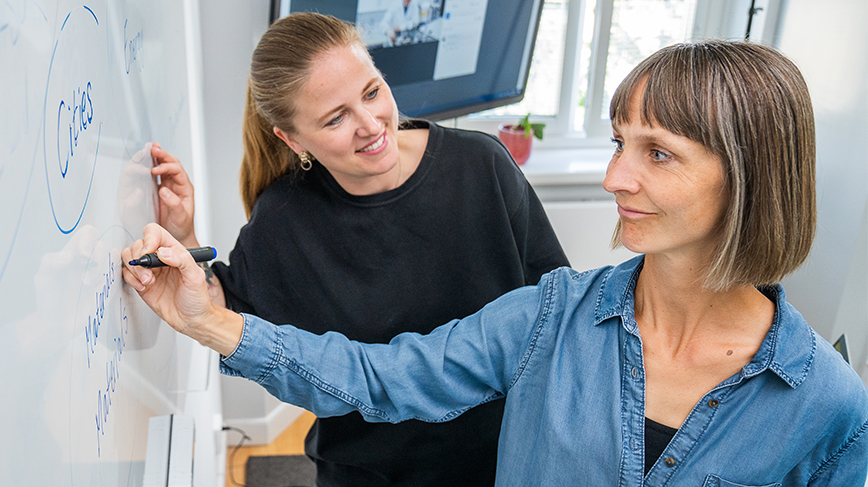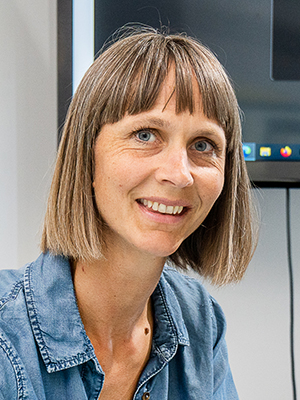New LinkedIn pages increase visibility for researchers’ news

To help researchers communicate their work externally to a narrow, specialised target group, Ulrika Georgsson came up with the idea of creating subject-specific Showcase Pages on LinkedIn. First off, Materials Science at KTH.
“It’s great when a post gets widely shared, like recently when we posted that a researcher had won a prize. After two days we had 20,000 views and 80 congratulation comments,” says Ulrika Georgsson, Communications Officer at the KTH School of Industrial Engineering and Management (ITM).
Ulrika Georgsson took the initiative for Showcase Pages on KTH’s LinkedIn page back in 2020 as a way of increasing visibility for researchers’ news and in response to wishes from various quarters within the university.

“I always try to encourage researchers to post more on our social media. Many of them are a bit wary and critical of it, and they’re concerned that getting involved is a bit populist,” she says.
Over time, LinkedIn itself has won credibility in the academic sector, and more and more researchers feel that a LinkedIn presence is good for their personal network and brand.
“Communicating via LinkedIn is a way of spreading news about your research, while you can also influence societal development as you reach other relevant scientists and decision-makers,” says Georgsson.
How does one go about getting content published on the KTH LinkedIn pages?
“Firstly a researcher sends me, as page manager, a notice about a study they’ve published or a new project, for example. It should be short, clear and concise so that my colleagues and I can consider whether it’s suitable for our followers. Researchers familiar with the procedure provide me with a couple of lines of explanatory text, which I can then edit and rejig before posting. But often I simply reply with a couple of questions and a request to pare the factual text down.”
What’s the biggest challenge for you as editor?
“We always spend some time on the brief texts in the posts, so we don’t forget to explain why it’s important to communicate the news and who we want to reach. We need to consider the reader.

“Sometimes I get a side and a half of A4 answering the questions, and the researcher wants all the info included. Unfortunately, that’s not possible if you want to reach people. Paring down your message to a couple of sentences is a good practice to get into.”
Since 2020 Martina Frick Isberg, Social Media Manager at KTH, has also been involved in the Showcase project, and a further two Showcase Pages have been started since then: Energy at KTH and Digitalisation at KTH , in cooperation with Maria Malmqvist, Communications Officer at EECS.
“When the Materials Science page started up as a pilot project during the pandemic to bring together all KTH’s expertise on the subject, it went really well and prompted a huge response from day one,” says Frick Isberg.
“On our new Showcase Pages, we communicate news from different schools divided into subject area, and that’s in line with KTH’s merging generally, whereby we’re communicating more and more across boundaries.”
How can someone start a new subject page for KTH on LinkedIn?
“First of all, think about what groups you want to reach, and think broadly in terms of the actual subject. Check out
the information page on the intranet
and contact your school’s or department’s communication officer to start the process.” (LINK)
After the initial idea, how long does it take to start a new subject page on LinkedIn?
“If you’ve thought about the kind of content you want to post, your target group and the follow-up process, that will speed things up,” says Frick Isberg.
“You also need to make sure there are sufficient resources available to manage the page, for instance when it comes to updating the content and responding to comments.
“Anyone who’s interested in reaching out via social media via a new channel, and who has questions about how to start a Showcase Page, is welcome to contact me directly at marfi@kth.se. There’s also basic information on the intranet .”
Text: Katarina Ahlfort
Photo: Magnus Glans
